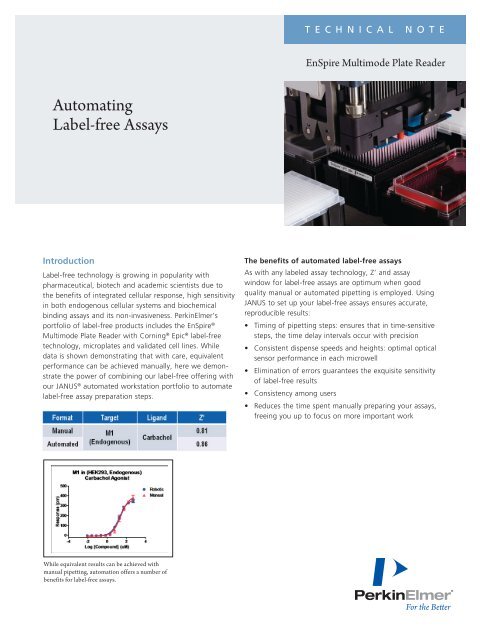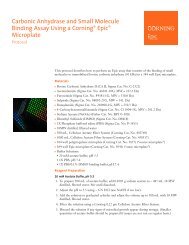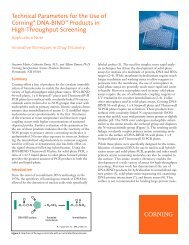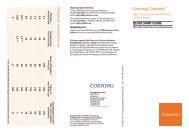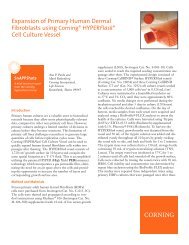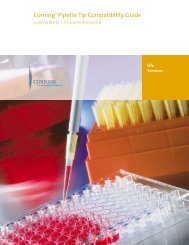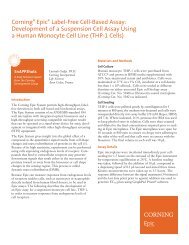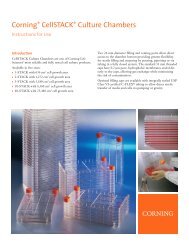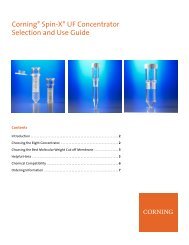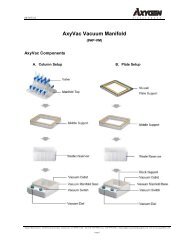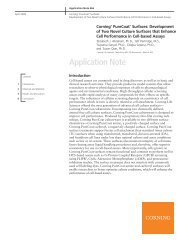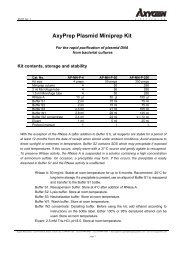Automating Label-free Assays using the EnSpire ... - PerkinElmer
Automating Label-free Assays using the EnSpire ... - PerkinElmer
Automating Label-free Assays using the EnSpire ... - PerkinElmer
You also want an ePaper? Increase the reach of your titles
YUMPU automatically turns print PDFs into web optimized ePapers that Google loves.
Technical Note<br />
<strong>EnSpire</strong> Multimode Plate Reader<br />
<strong>Automating</strong><br />
<strong>Label</strong>-<strong>free</strong> <strong>Assays</strong><br />
Introduction<br />
<strong>Label</strong>-<strong>free</strong> technology is growing in popularity with<br />
pharmaceutical, biotech and academic scientists due to<br />
<strong>the</strong> benefits of integrated cellular response, high sensitivity<br />
in both endogenous cellular systems and biochemical<br />
binding assays and its non-invasiveness. <strong>PerkinElmer</strong>’s<br />
portfolio of label-<strong>free</strong> products includes <strong>the</strong> <strong>EnSpire</strong> ®<br />
Multimode Plate Reader with Corning ® Epic ® label-<strong>free</strong><br />
technology, microplates and validated cell lines. While<br />
data is shown demonstrating that with care, equivalent<br />
performance can be achieved manually, here we demonstrate<br />
<strong>the</strong> power of combining our label-<strong>free</strong> offering with<br />
our JANUS ® automated workstation portfolio to automate<br />
label-<strong>free</strong> assay preparation steps.<br />
The benefits of automated label-<strong>free</strong> assays<br />
As with any labeled assay technology, Z’ and assay<br />
window for label-<strong>free</strong> assays are optimum when good<br />
quality manual or automated pipetting is employed. Using<br />
JANUS to set up your label-<strong>free</strong> assays ensures accurate,<br />
reproducible results:<br />
• Timing of pipetting steps: ensures that in time-sensitive<br />
steps, <strong>the</strong> time delay intervals occur with precision<br />
• Consistent dispense speeds and heights: optimal optical<br />
sensor performance in each microwell<br />
• Elimination of errors guarantees <strong>the</strong> exquisite sensitivity<br />
of label-<strong>free</strong> results<br />
• Consistency among users<br />
• Reduces <strong>the</strong> time spent manually preparing your assays,<br />
<strong>free</strong>ing you up to focus on more important work<br />
While equivalent results can be achieved with<br />
manual pipetting, automation offers a number of<br />
benefits for label-<strong>free</strong> assays.
Workflow steps in label-<strong>free</strong> cell based assays<br />
<strong>Label</strong>-<strong>free</strong> protocol steps that benefit <strong>the</strong> most from effective liquid handling<br />
Seed Cells<br />
BUFFER EXCHANGE<br />
• Effective mixing<br />
Incubate Cells Overnight<br />
Serum Starve Cells Overnight (Optional)<br />
Buffer Exchange<br />
Cell-based assays require >3<br />
aspirate and dispense cycles.<br />
Mixing reduces variability.<br />
Incubate Cells for 90 minutes at room temperature<br />
• Controlled dispense rate and height<br />
Loosely adherent cells require gentle buffer exchange<br />
Baseline Scan<br />
(30 min)<br />
COMPOUND DISPENSING<br />
• Minimal transfer time<br />
Agonist Assay<br />
Scan (60 min)<br />
Add Compounds<br />
1<br />
Agonist Assay<br />
Scan (30 min)<br />
384 pipetting head means reduced time<br />
between addition of compound to final<br />
well of plate vs. reading of first well of<br />
plate. Earlier signalling responses are<br />
thus observable in cell-based assays.<br />
Add Compounds<br />
2<br />
• Controlled dispense height<br />
Data Analysis<br />
Agonist Assay<br />
Scan (60 min)<br />
DMR signal<br />
increases by<br />
10-30% for each<br />
mm that dispense<br />
height is closer to<br />
well bottom.<br />
Z' increases as<br />
compound is<br />
dispensed closer<br />
to well bottom<br />
Data Analysis<br />
Dispense height is<br />
pre-set so no risk to<br />
bio-sensor or cell<br />
monolayer<br />
• Controlled dispense rate<br />
Faster response, higher signal response, lowered variability<br />
2<br />
3
Automated configurations to suit your label-<strong>free</strong> throughput and application<br />
Stand-alone Mini-JANUS<br />
Automated Workstation<br />
Ideal for lower throughput research applications<br />
such as GPCRs, ion channels and receptor tyrosine<br />
kinase assays<br />
Mini-JANUS with PlateStak<br />
Automated Microplate Handler<br />
Ideal for medium throughput biochemical endpoint<br />
assays in assay development and hit to lead<br />
areas. Applicable to small molecule and biologic<br />
and antibody drug development.<br />
The <strong>EnSpire</strong> stacker module includes 20- or 50-plate magazines, and is<br />
compatible with <strong>the</strong> PlateStak ® Automated Microplate Handler to allow<br />
efficient manual transfer of plates to <strong>the</strong> <strong>EnSpire</strong>.<br />
cell::explorer Automated Platform<br />
Complete HTS automation for drug discovery and<br />
stem cell research in a temperature controlled<br />
environment.<br />
<strong>PerkinElmer</strong>, Inc.<br />
940 Winter Street<br />
Waltham, MA 02451 USA<br />
P: (800) 762-4000 or<br />
(+1) 203-925-4602<br />
www.perkinelmer.com<br />
For a complete listing of our global offices, visit www.perkinelmer.com/ContactUs<br />
Copyright ©2011, <strong>PerkinElmer</strong>, Inc. All rights reserved. <strong>PerkinElmer</strong> ® is a registered trademark of <strong>PerkinElmer</strong>, Inc. Corning and Epic are registered trademarks of Corning Incorporated. All o<strong>the</strong>r trademarks are <strong>the</strong> property of <strong>the</strong>ir<br />
respective owners.<br />
009642_01 July 2011 Printed in USA


